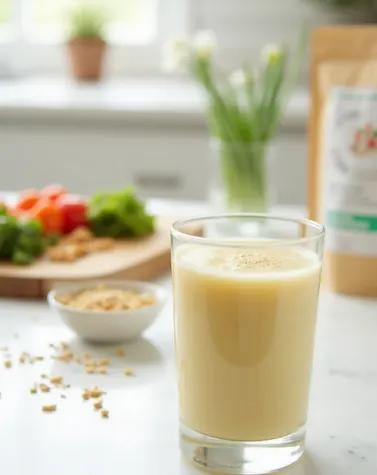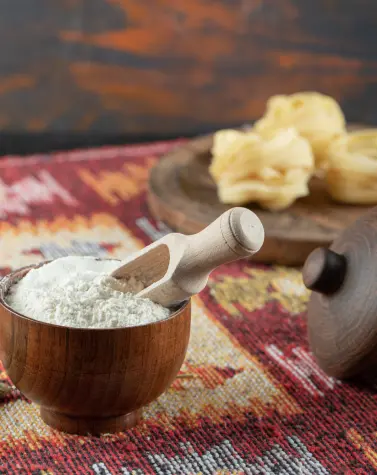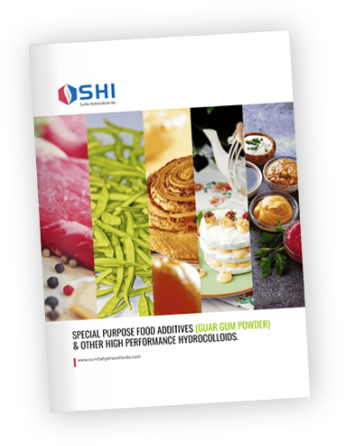
Is Guar Gum Gluten-Free? Understanding Its Role in Gluten-Free Cooking
Gluten free diets are getting popular day by day. For some people, going gluten free is a necessity due to celiac disease or gluten sensitivity; for others, it’s a lifestyle choice. Whichever your reason may be, if you are someone who is looking for a gluten free thickener to enjoy the food flavors, guar gum is just the ingredient for you.
Guar is a powerful ingredient used in gluten free cooking and baking. It acts as a substitute for gluten in traditional recipes to maintain the texture, elasticity and structure that gluten generally provides. Also known as guaran or cluster beans, guar gum is obtained from the seeds of the guar plant. It is native to India and Pakistan.
It is used in gluten-free flours and recipes for its binding properties. Guar gum traps moisture and prevents crumbling. Due to guar gum’s binding and thickening capabilities, it’s a must have in the gluten free kitchen.
What is Guar Gum?
Guar gum is a naturally occurring soluble fiber extracted from the guar bean of the guar plant. It is known for its thickening and stabilizing properties.
To produce guar gum:
- The guar seeds are dehusked and milled.
- The endosperm that contains galactomannan, a complex carbohydrate responsible for the guar gum’s thickening properties, is then separated.
- Next, the endosperm is ground into a fine guar gum powder.
This powder has eight times the thickening power of cornstarch. Adding just a small amount of guar gum can make a big difference in the consistency and shelf life of baked goods and processed foods. That is why it has wide application in the food industry.
Since it’s entirely plant-based and gluten-free, guar gum is used in:
- Gluten-free flour blends
- Sauces and soups
- Plant-based desserts and baked goods
Is Guar Gum Gluten-Free?

Guar gum is 100% gluten-free. It has no wheat, barley or rye. So it is safe for individuals with:
- Celiac disease
- Gluten sensitivity
- Wheat allergies
Not only this, guar gum is often added to gluten-free products to make up for the lack of gluten’s binding capabilities.
Benefits of Guar Gum in Gluten-Free Baking
Without gluten, baked goods can become crumbly, too dry, flat or dense. All in all, their texture suffers. Guar gum solves these issues by mimicking gluten’s elasticity and binding properties.
You should use guar gum in gluten free baking for:
- Improving dough elasticity
- Preventing crumbling
- Locking in moisture
- Enhancing rise and texture
- Extending shelf life
Just take a look at ingredients of gluten free cookies, muffins, pizza crusts or sandwich bread. You will see guar gum as an ingredient mentioned in these baked goods. It helps your baked goods come out as soft, stable and satisfying. You can use it at home for gluten free baking as well.
Understanding Gluten-Free Baking
Most gluten free flours or doughs do not have natural binding agents. Adding guar gum to your dough recreates the function of gluten. Thus, guar gum is added to the gluten free flour for:
- Holding ingredients together
- Trapping air during baking
- Improving the texture
Without a binder like guar gum, your baked goods may turn out dry, brittle or flat.
How to Use Guar Gum in Gluten-Free Recipes
Add the right amount of guar gum to get the perfect texture of your baked goods.
General Guar Gum Usage:
- For Breads and Pizza Dough: Add 1 to 1½ teaspoons per cup of gluten free flour
- For Cakes, Muffins, Quick Breads: Add ½ teaspoon per cup of gluten free flour
- For Cookies and Biscuits: Add ¼ to ½ teaspoon per cup of flour
Tips for Use:
- Mix with dry ingredients first to prevent clumping
- Use a digital scale if possible for precise measurement
- Avoid overuse, which can make textures slimy or gummy
Role of Guar Gum in Gluten-Free Cooking
Apart from baking, guar gum is an ingredient in gluten free cooking due to its versatile thickening properties.
- Soups and stews: Adds body and richness without gluten
- Salad dressings: Creates a smooth, emulsified texture
- Gravies and sauces: Provides thickness without flour
- Ice creams and frozen desserts: Prevents ice crystals from forming, keeps it creamy
Whether hot or cold, sweet or savory, guar gum adapts well to a wide range of dishes.
Guar Gum vs Other Ingredients
Guar gum is often compared with other thickening and binding agents. Here’s how it stacks up:
| Ingredient | Gluten-Free? | Best Uses | Notes |
| Guar Gum | Yes | Baked goods, sauces, soups | Affordable, effective, works in cold foods |
| Xanthan Gum | Yes | Baking, sauces | More expensive, better in high-heat recipes |
| Cornstarch | Yes | Sauces, puddings | Doesn’t bind well in baking |
| Psyllium Husk | Yes | Bread baking | Adds fiber, requires hydration |
Why choose guar gum?
Guar gum is more economical than xanthan gum. It also works well in both hot and cold temperatures.
Conclusion
Guar gum is gluten free—it gives structure, texture and elasticity to recipes that would otherwise be flat without gluten. Whether you’re baking a gluten free loaf, thickening a vegan gravy or making a dairy free dessert, guar gum gives consistency and performance.
As a natural, safe and affordable ingredient, guar gum has earned its place in the gluten free kitchen arsenal. With a little practice and the right ratios, it can make your gluten free creations taste as good, if not better, than the traditional version.
FAQs About Guar Gum
Q: What is guar gum and how is it used in gluten free cooking?
A: Guar gum is a plant based thickener and binder. It’s used to improve texture in gluten free recipes. You can find guar gum in the ingredients of gluten free bread, cakes and sauces.
Q: What are the benefits of guar gum in gluten free baking?
A: Guar gum is used in gluten free baking to add elasticity and moisture retention. It prevents crumbling and enhances the texture and mouthfeel of baked goods.
Q: How much guar gum should I use?
A: Start small and add ¼ to 1½ teaspoons per cup of gluten-free flour. The amount of guar gum varies as per the type of baked good.
Q: Is guar gum safe for people with celiac disease or gluten intolerance?
A: Yes, guar gum is gluten free. So it’s safe for people with celiac disease or gluten sensitivity.





